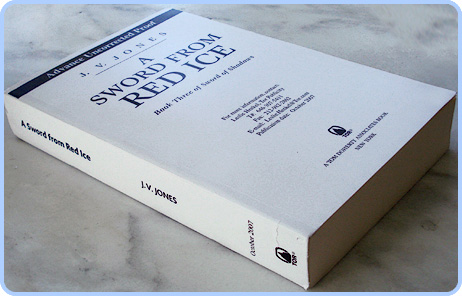Manuscript 101
J.V. Jones
May 23rd : 2007
|
Manuscript 101
|
|
|
J.V. Jones
|
May 23rd : 2007
|
|
Publishing a book takes a lot of work and coordination. Editors, copyeditors, typesetters, cover artists, production managers, and sales teams are just some of the people who will work on a book prior to publication. The production manager’s job is to coordinate the process of turning a raw manuscript into a bona fide bound book.  The copyeditor marks up the manuscript in colored pencil, and completes a style sheet which details the writer’s grammar preferences; and a word treatment sheet which records the spellings of fictional place and character names, and details how the writer deals with compound nouns (handknife or hand knife etc). The copyeditor then sends the manuscript to the writer for review. At this point the writer can agree to the copyeditor’s proposed changes or STET them (STET is Latin for “let it stand”). By jotting the word STET in the margin, the writer lets both the copyeditor and editor know that he wishes to retain his original wording. This is the final chance for the writer to make substantial changes in his work. Similarly, all dedications and acknowledgments must be included at this stage to ensure they make it into the finished book. The writer then sends this twice-marked manuscript (he uses a different colored pencil than the copyeditor), complete with author bio, photo, acknowledgments and dedication, to the editor so she can look through it one final time before initiating the typesetting process. During this period the editor has not been idle. In addition to content, she’s responsible for the look, length and cover of the book. After her initial reading of the manuscript, she meets with the art department to discuss the cover. Ideas are exchanged, and an artist is commissioned to paint, draw, or photograph the cover art for the book. The cover might be “wraparound” meaning one continuos painting serves as both back and front of the book, or single face meaning the artwork is limited to the front cover. At this point the artist is often given a copy of the raw manuscript to better help him understand the mood of the work, or to provide specific details if the commissioned art is to illustrate a scene from the book. The artist will then submit a rough sketch, usually rendered in charcoal or crayon, and the editor and artwork department will decide if any changes need to be made before the artist begins the final piece. Meanwhile, the art department will use the rough sketch to mock up a book cover. Details such as the size and position of the title, the typeface and type size, and whether or not the title will be “foiled” or “raised” will be decided here. By this time, the production department already knows know how long the book will run, having “cast” the manuscript to determine how many pages it will take to print it. Once they receive the approved copy-edited manuscript from the editor, the manuscript is typeset into page proofs. Every sheet of a page proof represents a page from the actual, finished book. The sheets are numbered and headed just as they will appear in the book, and at this stage the editor, copyeditor and writer will all review the page proofs, looking for format errors, typos and any other last minute mistakes. At this point the writer’s hands are tied. If he finds something he’d like to change now it’s hard luck. The page count of the book has been finalized. While the production side of the book is underway, the marketing department is also working to promote the book to booksellers. Cover flats are produced, which are high quality printed copies of the book cover (back, spine and front) which sales reps take to buyers to give them an idea how the bound book will look. Also, galley copies are produced. These are actual rough-bound books which are produced inexpensively in small numbers. Galleys are distributed to buyers, reviewers, writers who might be persuaded to provide “cover blurbs”, and store clerks etc, with the idea of generating positive word of mouth, press coverage and increasing presale numbers. Also, at this time, the publisher’s press office will be gearing up to promote both the writer and the book. Press releases, publicity photos, book tour itineraries and radio and print interviews will be coordinated to coincide with the book’s publication. Once the page proofs have been reviewed the book goes to press, and within a matter of weeks the book will be on bookstore shelves, ready to buy. Special considerations such as end of shelf displays, window displays, and freestanding promo displays will have been decided on beforehand, determining the book’s “presence” in the store. A high priority book will be given extra shelf space and superior placement. This is not a static system, however, for any book that gains sales momentum will rise up the ladder. If sales are going well, the publisher will send the book back to press and release a second edition (you can tell the edition number any of your books by looking on the inside title page). Eventually, when sales begin to fall off, the publisher will release the mass market (paperback) edition and the sales team will once again begin selling the books to stores and distributors. |